Submitted:
26 February 2024
Posted:
26 February 2024
You are already at the latest version
Abstract
Keywords:
1. Introduction
2. History
3. Geological Setting
3.1. Setting of the Barite Orebody
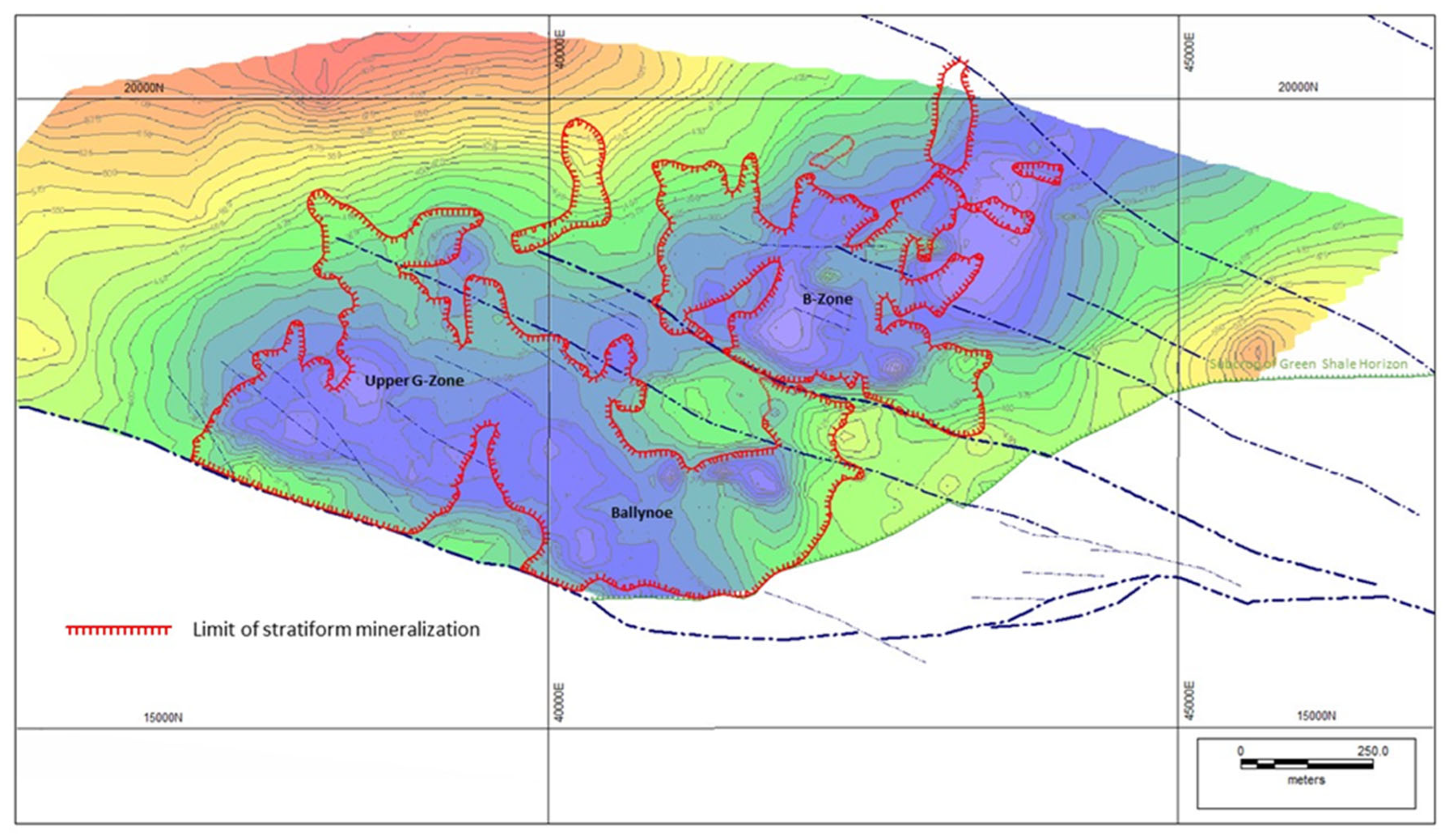
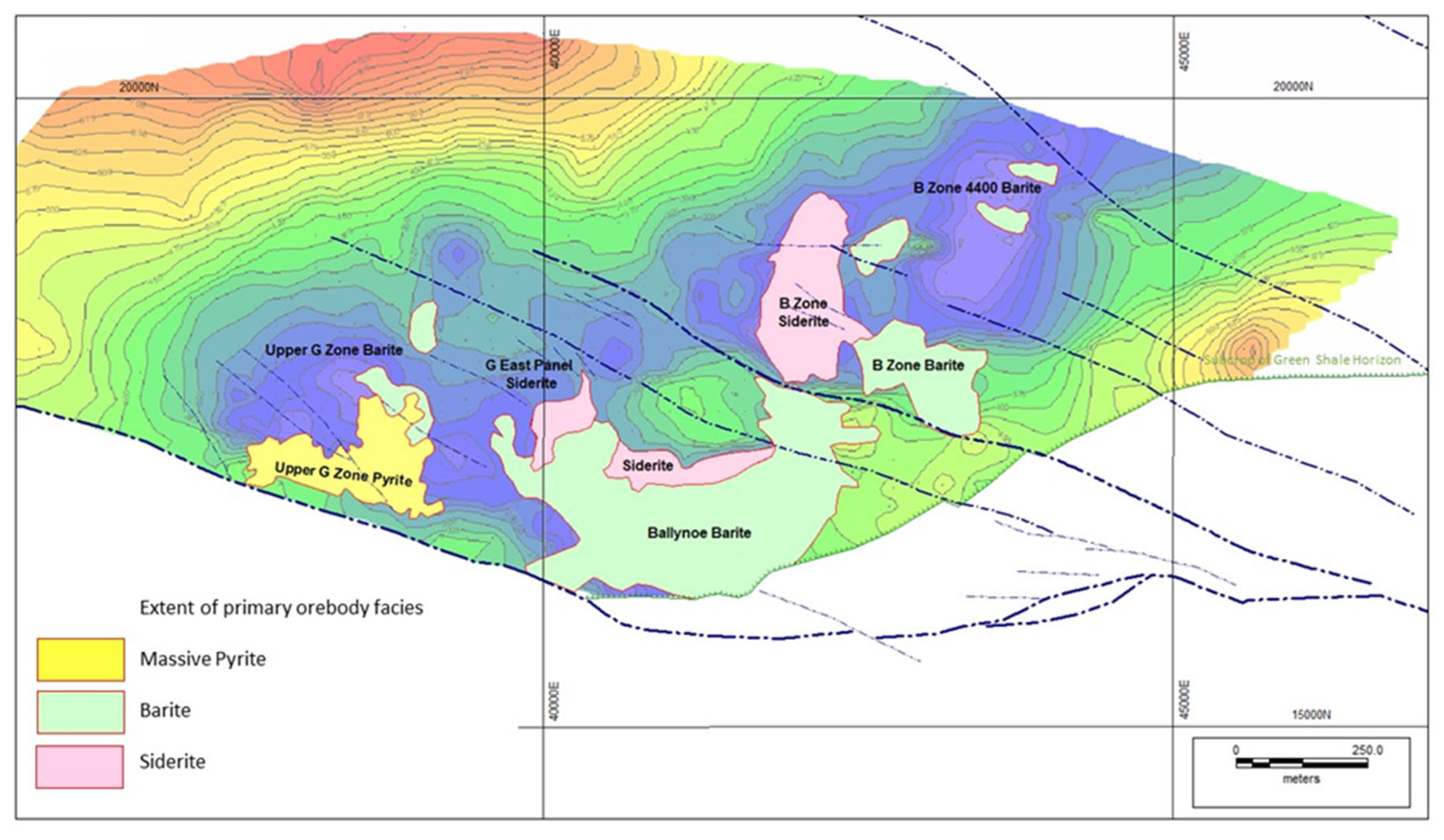
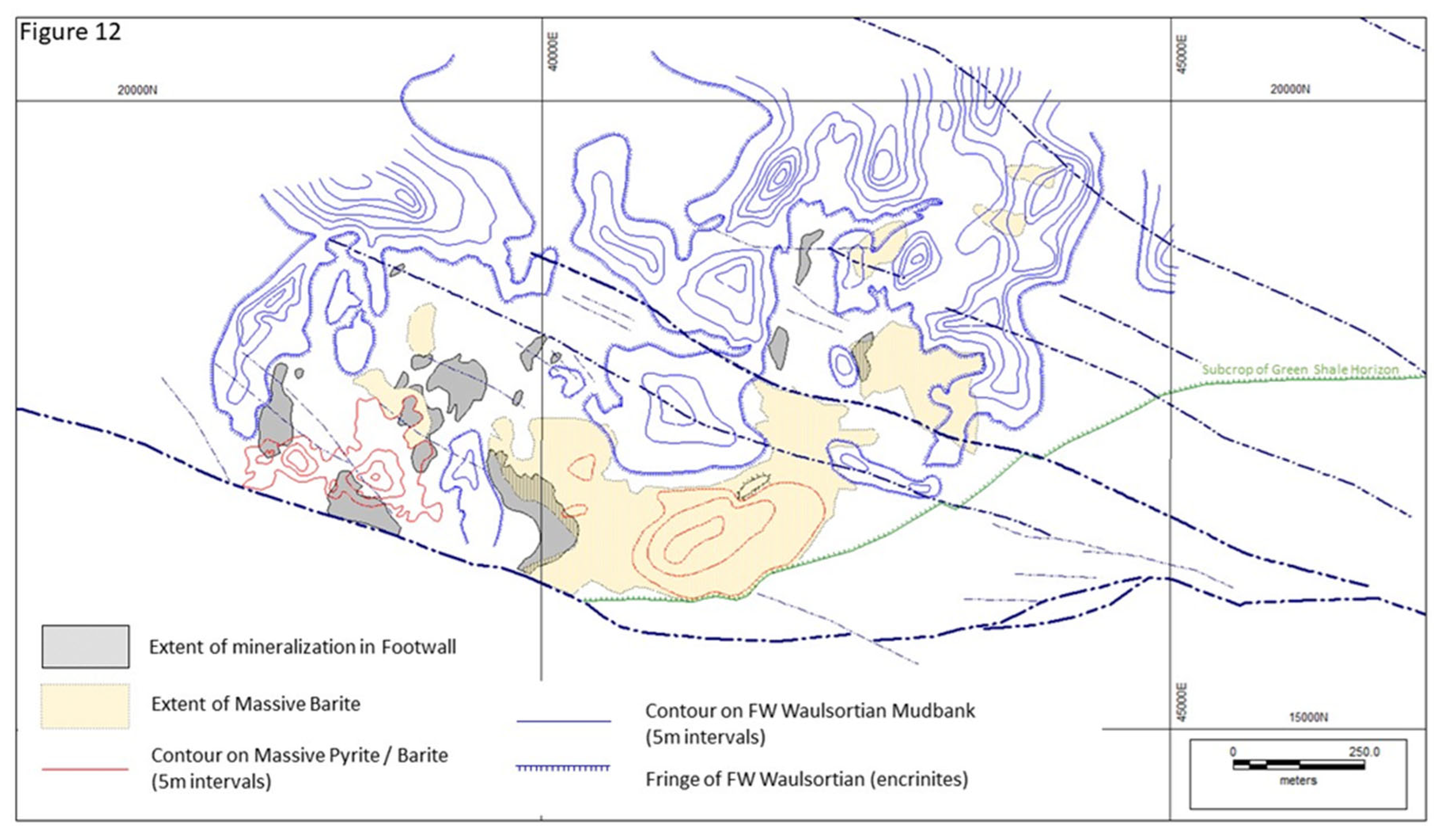
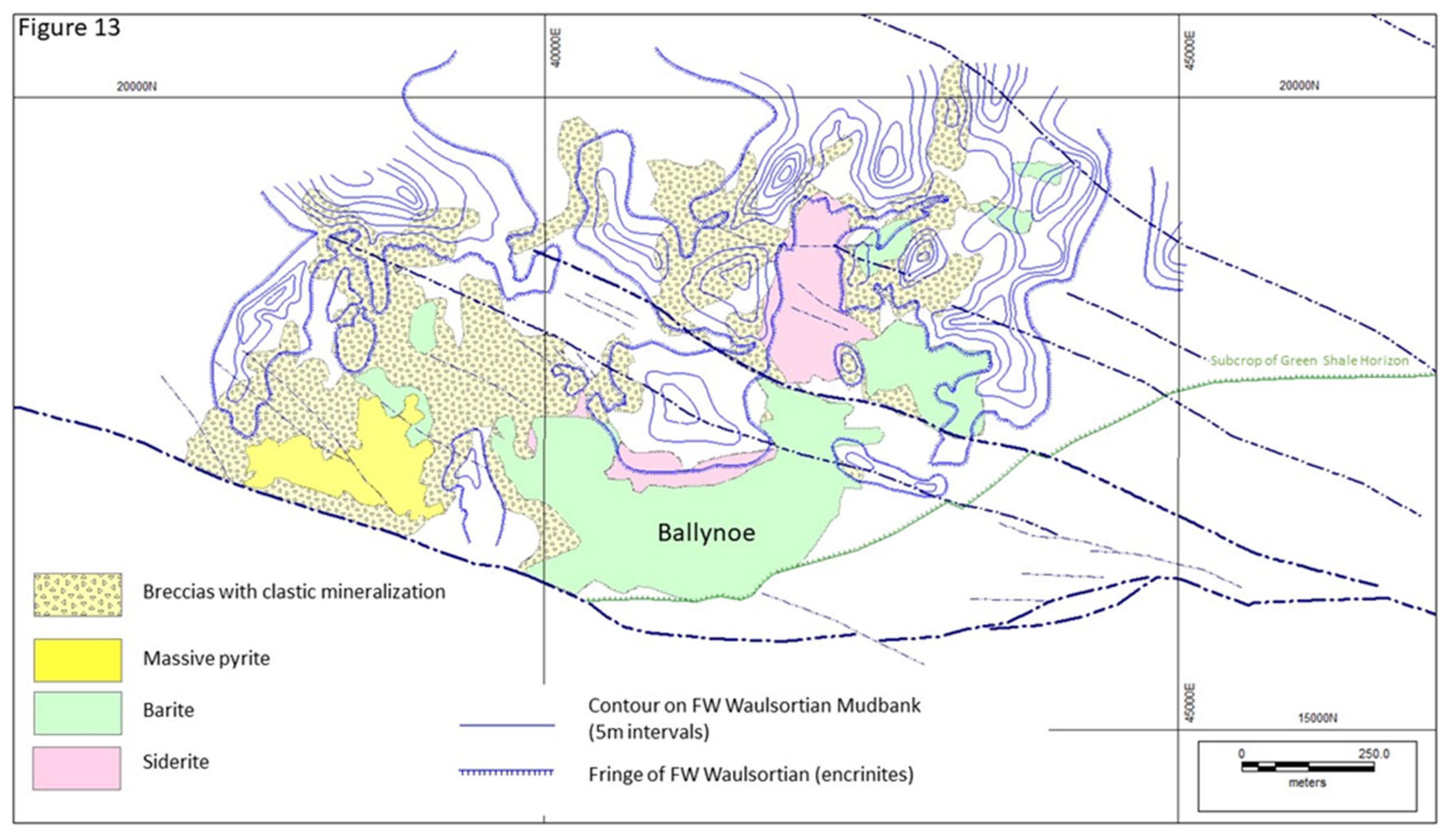
3.2. Nature of the Barite Orebody
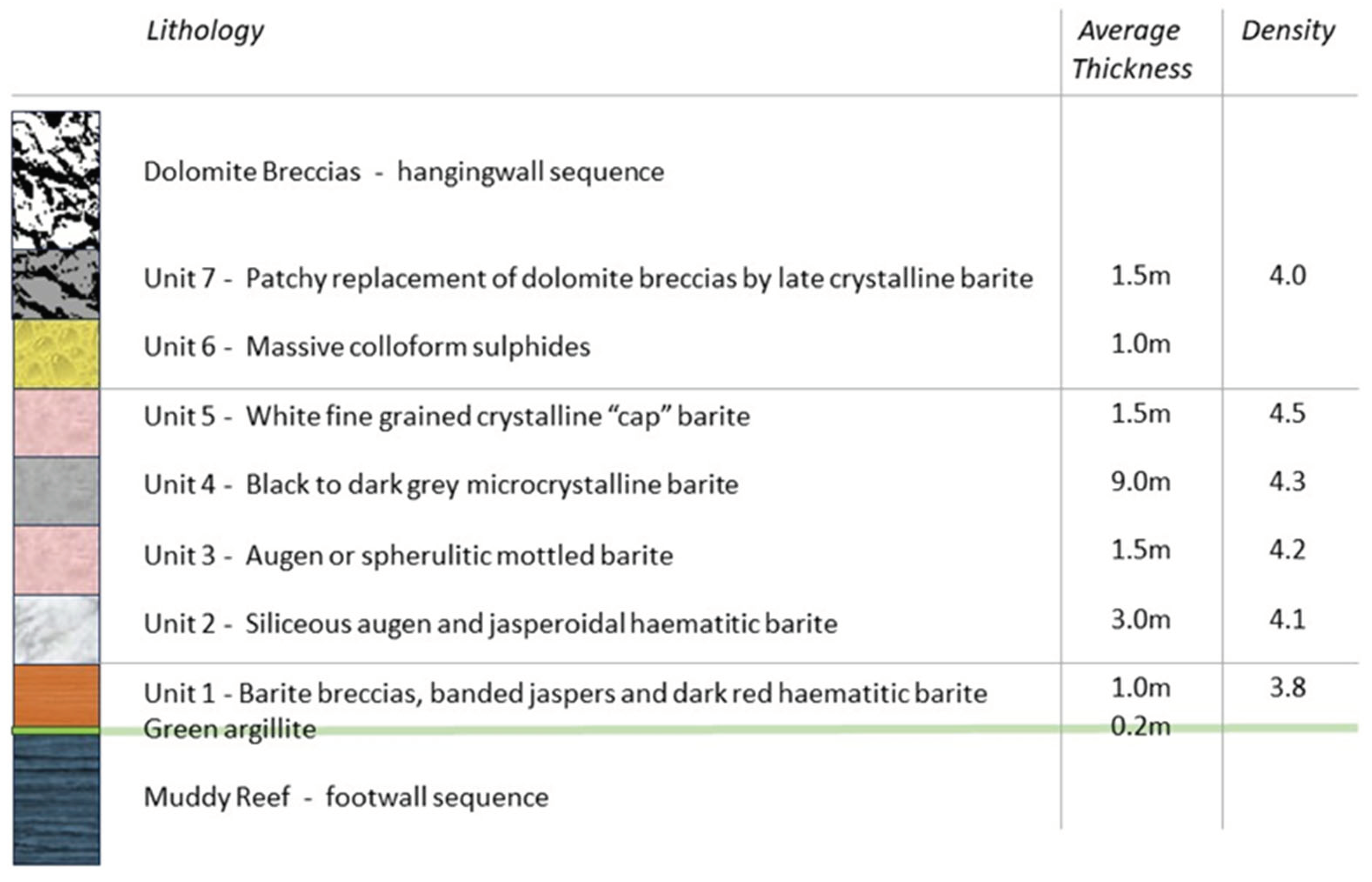
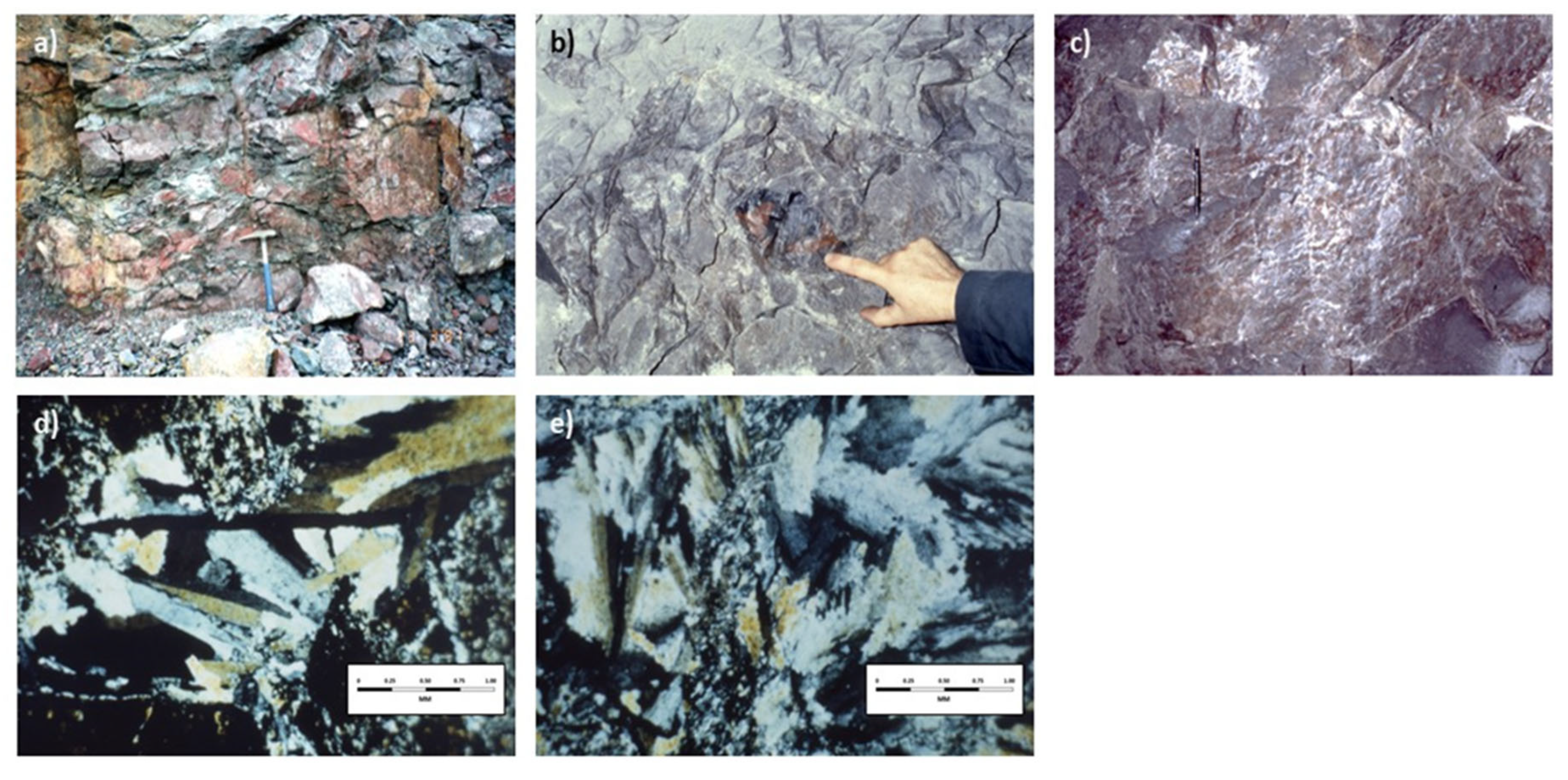
4. Geochemistry
4.1. Biota in the Barite Orebody
4.2. Fluid Inclusions
4.3. Strontium Content and Isotopic Ratios
4.4. Stable Isotopes of Hydrogen, Oxygen and Sulphur
4.5. Hangingwall Breccias
5. Discussion
6. Summary
ADDENDUM
- Barite Elsewhere in the Irish Midlands Ore District and Surrounds (Figure 1)
Acknowledgments
References
- Andrew, C.J . (2023) Irish Zn-Pb deposits – a review of the evidence for the timing of mineralization. Constraints of stratigraphy and basin development. In: Andrew, C.J., Hitzman, M.W. & Stanley, G. ‘Irish-type Deposits around the world’, Irish Association for Economic Geology, Dublin. 169-210. [CrossRef]
- Andrew, C.J. (1986) The tectono-stratigraphic controls to mineralization in the Silvermines area, County Tipperary, Ireland. In: Andrew, C.J., Crowe, R.W.A., Finlay, S., Pennell, W.M., and Pyne, J.F. ‘Geology and Genesis of Mineral Deposits in Ireland’, Irish Association for Economic Geology, Dublin. 377-418. [CrossRef]
- Ashton, J.H., Andrew, C.J. & Hitzman, M.W. (2023) Irish-type Zn-Pb deposits - What are they and more? In: Andrew, C.J., Hitzman, M.W. & Stanley, G. ‘Irish-type Deposits around the world’, Irish Association for Economic Geology, Dublin. 95-146. [CrossRef]
- Wynne, A.B., & Kane, G.H. (1861) Memoir to accompany Sheet N° 154. Mem. Geol. Sur. Ireland, 52pp.
- Griffith, S.V. (1956) The Silvermines operation. Co . Tipperary, Eire. Mining Magazine; Serialized March 1955 - January 1956. 19 March.
- Rhoden, H.N. (1958) Structure and economic mineralization of the Silvermines district, Co. Tipperary, Ireland. Trans. Inst. Mining & Metall. (Sect. B: Appl. Earth. Sci) v. 68. p. 67-94.
- Barrett, J. R. (1975) Genesis of the Ballynoe barite deposit, Ireland and other stratabound deposits of the United Kingdom. Unpub. Ph.D. thesis, University of London 260pp.
- Taylor, S. & Andrew, C.J. (1978) Silvermines orebodies, Co. Tipperary, Ireland Trans. Inst. Mining &. Metall. (Sect. B: Appl. Earth sci.) , 87, B111 - 124.
- Taylor, S., (1984), Structural and palaeotopographic controls of lead-zinc mineralization in the Silvermines orebodies, Republic of Ireland: Economic Geology, v. 79, p. 529-548.
- Andrew, C.J (1995) The Silvermines District, Ireland. In: Anderson, I.K., Ashton, J.H., Earls, G., Hitzman, M.W. & Tear, S. (eds). Irish Carbonate-hosted Zn-Pb Deposits (Guidebook Series, Volume 21). Society of Economic Geologists. pp 247-258.
- Mullane, M.M_& Kinnaird, J.A. (1998) Synsedimentary mineralization at Ballynoe barite deposit, near Silvermines, Co. Tipperary, Ireland. Trans. Inst. Mining. Metall. (Sect. B: Appl. earth sci.), 107, B48-61.
- Greig, J.A., Baadsgard, H., Cumming, G.L., Folinsbee, R.E., Krouse, H.R., Ohmoto, H., Sasaki, A., & Smejkal, V., (1971) Lead and sulfur isotopes of the Irish base metal mines in Carboniferous carbonate host rocks, In: Proc. lMA-IAGOD meetings '70, Joint symposium volume: Tokyo, Society of Mining Geologists of Japan special issue no. 2, p. 84-92.
- Coomer, P.G. & Robinson. B.W. (1976) Sulphur and sulphate - oxygen isotopes and the origin of the Silvermines deposits, Ireland, Mineralium Deposita, v, 11. p. 155- 169.
- Larter, R.C. L ., Boyce. A. J. & Russell, M.J. (1981) Hydrothermal pyrite chimneys from the Ballynoe barite deposit, Co. Tipperary, Ireland. Mineralium Deposita, v. 16. p. 309-3 18.
- Bruck, P.M. (1982) The regional lithostratigraphic setting of the Silvermines zinc-lead and the Ballynoe barite deposits, Co. Tipperary. In: Brown, A. (Ed.) Mineral Exploration in Ireland Progress and developments 1971-1981. Dublin ; Ir. Assoc. Econ. Geol. p. 162-170.
- Boyce, A.J., Coleman, M.L. & Russell, M.J. (1983). Formation of fossil hydrothermal chimneys and mounds from Silvermines, Ireland. Nature, 306, 545-550. [CrossRef]
- Boyce, A.J., Little, C.T.S. & Russell, M.J. (2003). A new fossil vent biota in the Ballynoe Barite deposit, Silvermines, Ireland: evidence for intracratonic sea-floor hydrothermal activity about 352 Ma. Economic Geology, 98, 649-656.
- Grennan, E.F. & Andrew, C.J. (2019) The Mining Heritage and History of the Silvermines area, County Tipperary, Ireland since the 13th century. European Geologist Journal. v.48 43-48.
- Philcox, M. (1984) Lower Carboniferous Lithostratigraphy of the Irish Midlands, Dublin: Ir. Assoc. Econ. Geol., 89pp.
- Lees, A., (1964) The structure and origin of the Waulsortian (Lower Carboniferous) 'reefs' of west-central Eire: Philosophical Transactions of the Royal Society of London, series B, v. 247, p. 483-531.
- Lees, A. & Miller, J. (1985) Facies variation in Waulsortian buildups, part 2; mid-Dinantian buildups from Europe and North America. Geol Jour. 20. pp159–180.
- Lees, A. & Miller, J. (1995) Waulsortian banks. In: Monty CLV, Bosence DWJ, Bridges PH, Pratt BR (eds) Carbonate mudmounds. International Association of Sedimentologists Spec Publ 23. Blackwell Science, Oxford, pp 191–271.
- Phillips, W.E.A. & Sevastopulo, G.D., (1986), The stratigraphic and structural setting of Irish mineral deposits, in Andrew, C.J., Crowe, R.W.A., Finlay, S., and Pyne, J.F., eds., Geology and genesis of mineral deposits in Ireland: Dublin, Irish Association of Economic Geologists, p1–30.
- Andrew, C.J. (1993) Mineralization in the Irish Midlands. In: Pattrick, R.A.D. & Polya, D.A. (eds). Mineralization in the British Isles. Chapman & Hall, London. pp 208-269.
- Hitzman, M.W. (1999) Extensional faults that localize Irish syndiagenetic Zn-Pb deposits and their reactivation during Variscan Compression. In: McCaffrey, K.J.W., Lonergan, L. and Wilkinson, J.J. (Eds), Fractures, Fluid Flow And Mineralization. Geological Society, London, Special Publications 1999; v. 155; p. 233-245.
- Strogen, P. (1988) The Carboniferous lithostratigraphy of Southeast County Limerick, Ireland, and the origin of the Shannon trough. Geological Journal, v. 23, Issue 2, 121-137.
- Koch, H.A.; Chew, D.; Hitzman, M.; Slezak, P.; Dunleavy, E; & Holdstock. M. (2022) Age constraints of the mineralized Waulsortian limestone formation by dating of Irish volcanic ash layers. Abstract Volume IAEG Conference “Getting back to business”.
- Kyne, R., Torremans, K., Güven, J., Doyle, R. & Walsh, J. (2019) 3-D Modelling of the Lisheen and Silvermines Deposits, County Tipperary, Ireland: Insights into Structural Controls on the Formation of Irish Zn-Pb Deposits. Economic Geology, v. 114, no. 1, pp. 93–116.
- Graham. R. A. (1970) The Mogul base- metal deposits , Co, Tipperary, Ireland, Unpub. PhD thesis, Univ. of Ontario. 227pp.
- Locklin. J.A. (1983) Petrologic analysis of core samples from the Silvermines mineral district, Co. Tipperary. Getty Research Center, Research Report. 83/421. 28pp.
- Schultz, R.W. (1966) Lower Carboniferous Cherty Ironstones at Tynagh, Ireland. Econ.Geol. Vol.61, pp. 311-342.
- Catlin, S. (1983) Irish Base Metals core description: Mineralization in core samples from the Silvermines Area, Ireland. Getty Research Center, Research Report 83-325, 22pp.
- Gross, G.A. (1972) Primary features in cherty iron formations. Sed. Geol. v.7, pp. 241-261.
- Pratt, B.R. (1998) Syneresis cracks: Subaqueous shrinkage in argillaceous sediments caused by earthquake-induced dewatering. Sedimentary Geology, 117(1):1-10. [CrossRef]
- Lee, M.J. & Wilkinson, J.J. (2002). Cementation, hydrothermal alteration and Zn-Pb mineralization of carbonate breccias in the Irish Midlands: Textural evidence from the Cooleen Zone, near Silvermines, Co. Tipperary. Economic Geology, 97, pp653-662.
- Rustichelli, A.; Tondi, E.; Korneva, I.; ,Baud, P.; Viniguerra, S.; Agista, F., Reuchele, T. & Janiseck, J-M. (2015) Bedding-parallel stylolites in shallow-water limestone successions of the Apulian Carbonate Platform (central-southern Italy) Ital. J. Geosci., Vol. 134, No. 3 (2015), pp. 513-534.
- Desbruères, D., Gaill, F., Laubier, L, Fouquet, Y. (1985). Polychaetous annelids from hydrothermal vent ecosystems: an overview. In: Jones, M.L. (ed.) The hydrothermal vents of the Eastern Pacific: an overview. INFAX Corporation, Vienna, Virginia, p. 103–116. (Bull. biol. Soc. Wash. No. 6).
- Russell, M.J. (1996) The generation at hot springs of sedimentary ore deposits, microbialites and life. Ore Geology Reviews, v 10, 199-214.
- Juniper, S.K. & Fouquet, Y. (1988) Filamentous iron-silica deposits from modern and ancient hydrothermal sites. Can. Mineral., 26, pp. 859-869.
- Peng, X., Zhou, H.H., Tang, S., Yao, H., Jiang, L. & Wu, Z. (2008) Early-stage mineralization of hydrothermal tubeworms: new insights into the role of microorganisms in the process of mineralization Chin. Sci. Bull., 53, pp. 251-261. [CrossRef]
- Oudin, E., Bouladon, J. & Paris, J.P (1985) Vers hydrothermaux fossils dans une mineralisation sulfuree des ophiolites de Nouvelle–Calédonie Acad. des Sci. Compte Rendus Ser. II, 301, pp. 157-162.
- Kuznetsov, A.P., Maslennikov, V.V. & Zaikov, V.V (1993) The near-hydrothermal fauna of the Silurian paleo-ocean in the south Ural. Izv. Akad. Nauk SSSR Ser. Biol., 4, pp. 525-534. Izv. Akad. Nauk SSSR Ser. Biol.
- Kucha, H. (2017) Bacterially induced: micro- to nano-textures, intermediate and mixed sulfur valences, and S isotopes of massive sulphides, Silvermines Zn-Pb deposit, Ireland. Available online: https://www.researchgate.net/publication/325827752_Silvermines_Book.
- Little, C.T.S. & Thorseth, I.H. (2002) Hydrothermal vent microbial communities: a fossil perspective. Carh. Biol. Mar.43 : 317-319.
- Samson & Russell, M.J. (1983) . Fluid inclusion data from the Silvermines lead - zinc - barite deposits, Ireland . Trans. Inst. Mining & Metall. (Sect. B: Appl, Earth Sci v. 92, p. 67-71.
- Bruckschen, P., Bruhn, F., Veizer, J. & Buhl, D. (1995) 87Sr/86Sr isotopic evolution of Lower Carboniferous seawater: Dinantian of Western Europe. Sedimentary Geology, 100, Issue 1, p. 63-81. [CrossRef]
- Bruckschen, P., Oesmann, S., Veizer, J., (1999) Isotope stratigraphy of the European Carboniferous: Proxy signals for ocean chemistry, climate and tectonics. Chemical Geology 161, 127-163.
- Snoeck, C., Ryan, S.,Pouncett, J., Pellegrini, M., Claeys, P., Wainwright, A.N., Mattielli. N., Lee-Thorp, J.A. & Schulting, R.J. (2020) Towards a biologically available strontium isotope baseline for Ireland. Science of the Total Environment, 712, (2020) 136248. [CrossRef]
- Schneider, J., von Quadt, A., Wilkinson, J.J. & Boyce, A.J. (2007) Age of the Silvermines Irish-type Zn-Pb deposit from direct Rb-Sr dating of sphalerite. In: "Digging Deeper" C.J. Andrew et al (editors) - Proceedings of the Ninth Biennial SGA Meeting, Dublin 2007, p373-376.
- Jitao Chen, Bo Chen & Montañez, I.P (2020) Carboniferous isotope stratigraphy Geological Society London Special Publications 512(1), 197-211.
- Thode, A.G. & Monster, J. (1965) Sulphur isotope geochemistry of petroleum evaporites and ancient seas. In: Fluids in subsurface environments (Eds: Young, A. & Galley. J, E.) Am. Assoc. Petrol. Geol . v. 4, 367-377. In: Fluids in subsurface environments.
- Fallick, A.E.; Ashton, J.H.; Boyce, A.J.; Ellam, R.M.; Russell, M.J. (2001) Bacteria were responsible for the magnitude of the world-class hydrothermal base-metal orebody at Navan, Ireland. Econ. Geol., 96, 885–890.
- Boyce, A.J., Fallick, A.,E., Mullen, G., Drummond, D. & Doran, A.(2023) Taking account of sulfur isotope geochemistry in the genesis of Irish-type base-metal deposits. Presentation at ‘Irish-type Deposits around the world’, Irish Association for Economic Geology. Available online: https://view.officeapps.live.com/op/view.aspx?src=https%3A%2F%2Fiaeg.ie%2Fresources%2FDocuments%2FBoyce.pptx&wdOrigin=BROWSELINK.
- Filion, M. (1973) Economic geology and geostatistics of base metal mineralisation at Silvermines, Ireland, Unpub. PhD. thesis, University of London, 360pp.
- Griffith, E.M. & Paytan, A. (2012) Barite in the ocean – occurrence, geochemistry and palaeoceanographic applications. Sedimentology. [CrossRef]
- Holdstock. M. P. (1982) Breccia-hosted Zinc-Lead mineralization in Tournaisian and Lower Visean Carbonates at Harberton Bridge, County Kildare. In: Brown, A.G. and Pyne, J.F. (eds.), Mineral Exploration in Ireland: Progress and Developments 1971-1981. Irish Association for Economic Geology, Dublin 83·91.
- Andrew, C.J. & Stanley, G. (2023) Irish, but not Irish-type. In: Andrew, C.J., Hitzman, M.W. & Stanley, G. ‘Irish-type Deposits around the world’, Irish Association for Economic Geology, Dublin. 211-230. [CrossRef]
- Guven, J., Torremans, K., Johnson, S. & Hitzman, M. (2023) The Rathdowney Trend, Ireland: Geological evolution and controls on Zn-Pb mineralization. In: Andrew, C.J., Hitzman, M.W. & Stanley, G. ‘Irish-type Deposits around the world’, Irish Association for Economic Geology, Dublin. 329-362. [CrossRef]
- Vafeas, N., Slezak, P., Chew, D., Brodbeck, M.; Hitzman, M. & Hnatyshin, D. (2023). U-Pb dating of apatite from Silvermines deposit, Ireland: A model for hydrothermal ore genesis. Economic Geology. v. 118. [CrossRef]
- Slowey, E.P. (1986) The Zn-Pb and barite deposits at Keel, County Longford. In: Andrew, C.J., Crowe, R.W.A., Finlay, S., Pennell, W.M., and Pyne, J.F. ‘Geology and Genesis of Mineral Deposits in Ireland’, Irish Association for Economic Geology, Dublin. 319-330. [CrossRef]
- Jewell, P.W. (2000) Bedded barite in the Geological Record Jewell_SPEM_SpecPub_2000.pdf (utah.edu).
- Mahmoodi, P., Peter, J.M., Rajabi, A. & Rastad, E. (2023) Geological and textural characteristics as evidence for Irish-type mineralization in the Eastern Haft-Savaran deposit In: Andrew, C.J., Hitzman, M.W. & Stanley, G. ‘Irish-type Deposits around the world’, Irish Association for Economic Geology, Dublin. 533-544. [CrossRef]
- Rajabi, A., Mahmoodi, P., Rastad, E., Canet, C., Alfonso, P., Niroomand, S., Tarmohammadi, A., Perrnajmodin, H. & Akbari, Z. (2023) An introduction to Irish-type Zn-Pb deposits in early Cretaceous carbonate rocks of Iran. In: Andrew, C.J., Hitzman, M.W. & Stanley, G. ‘Irish-type Deposits around the world’, Irish Association for Economic Geology, Dublin. 511-532. [CrossRef]
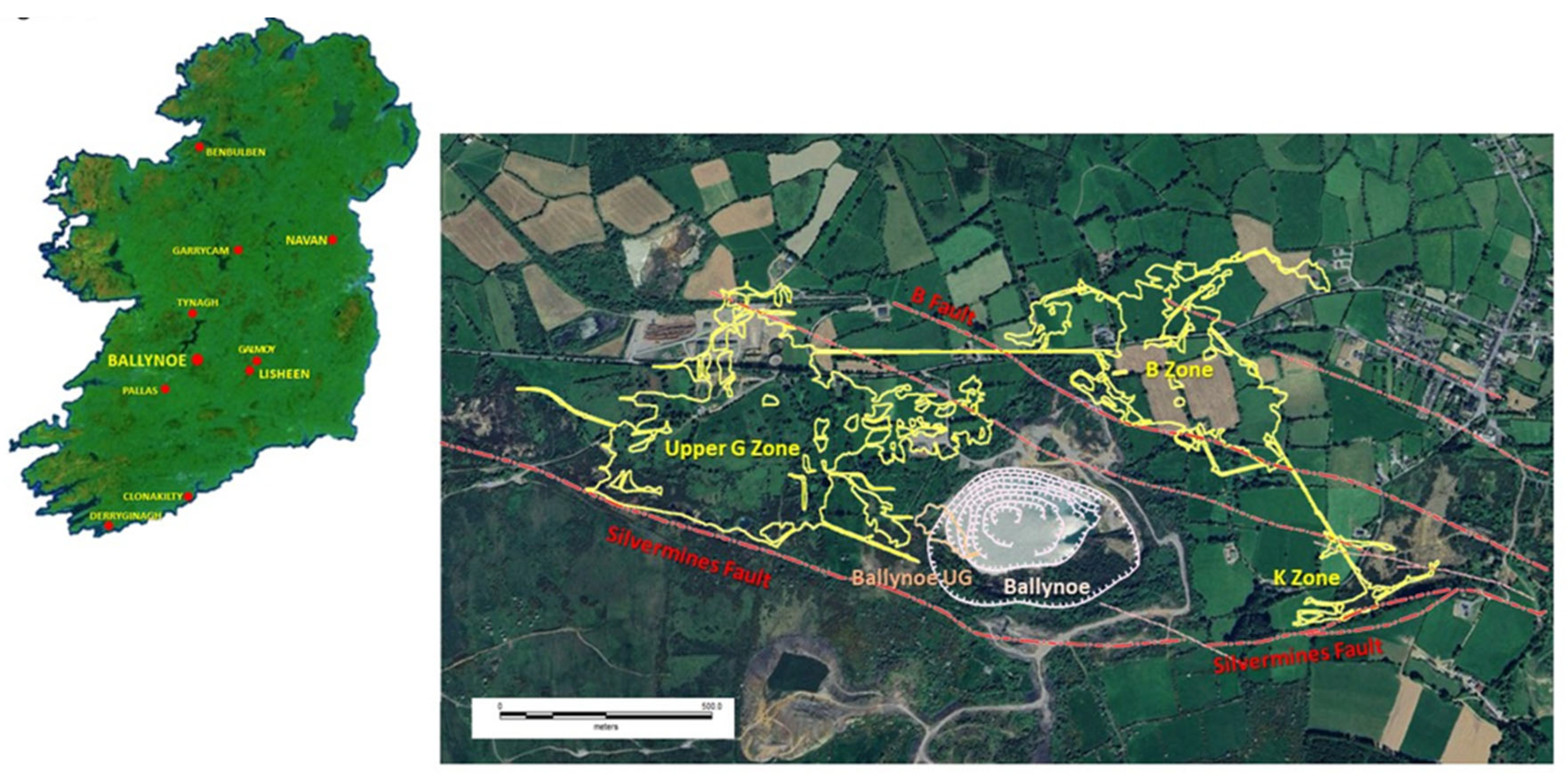
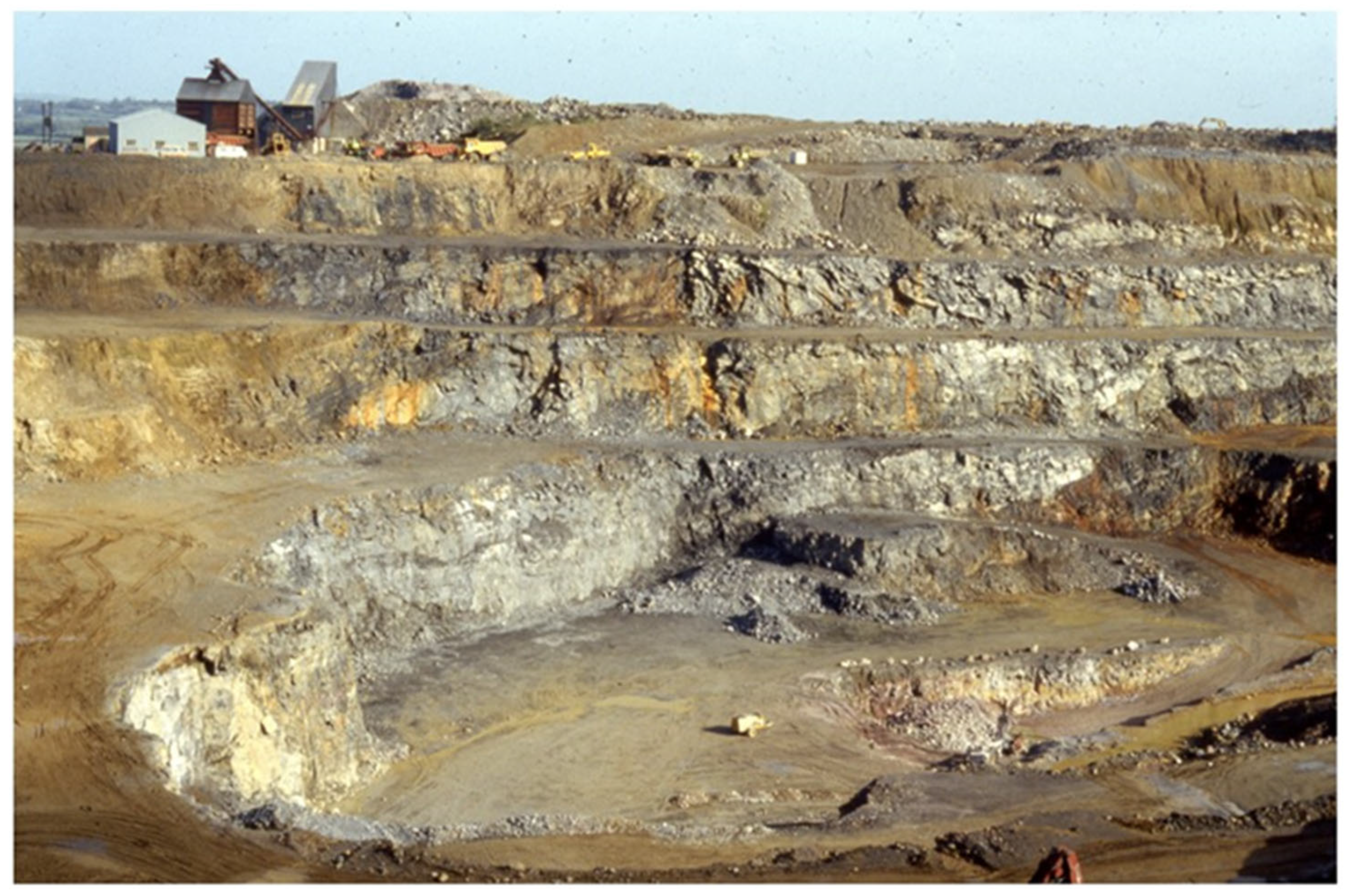
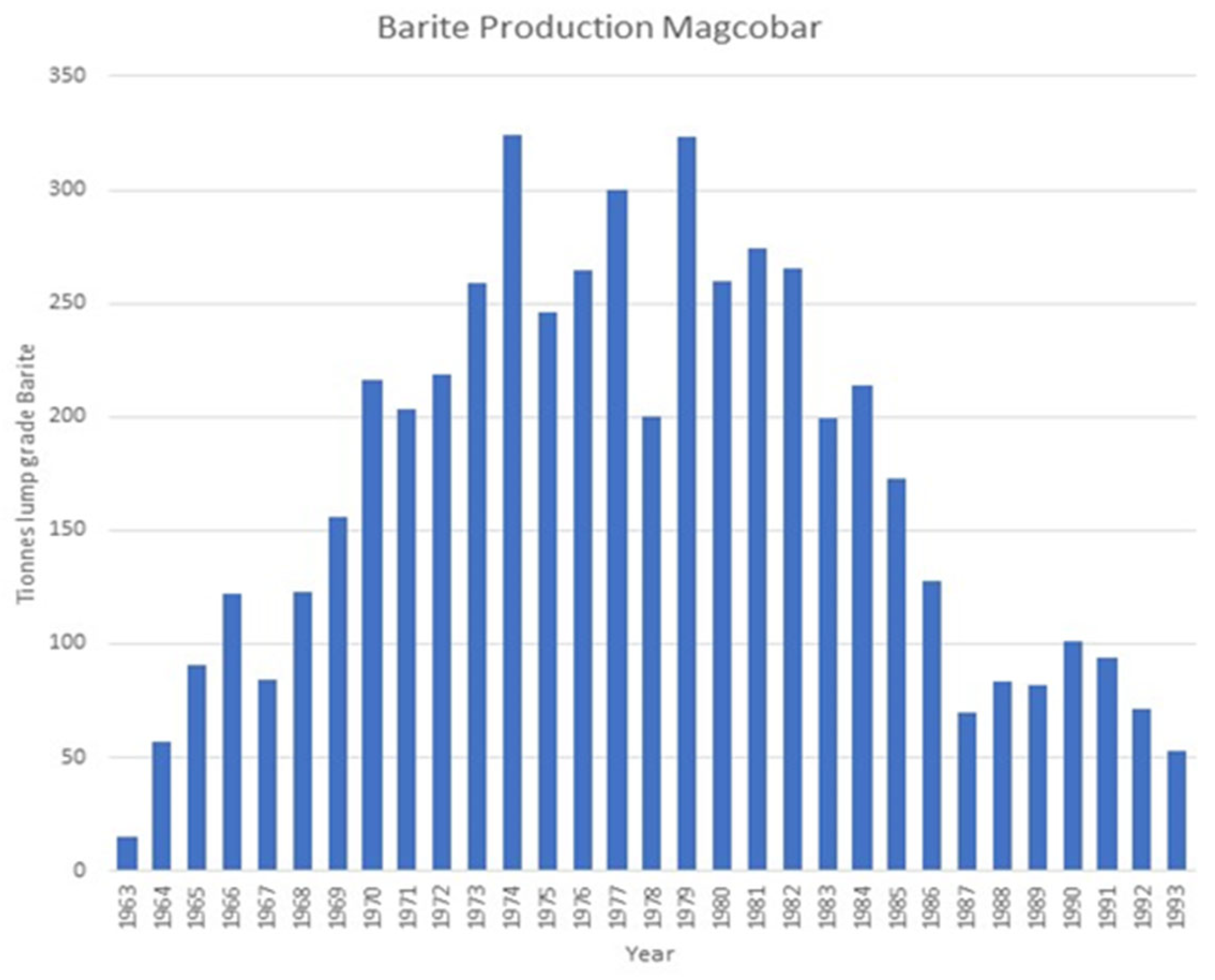
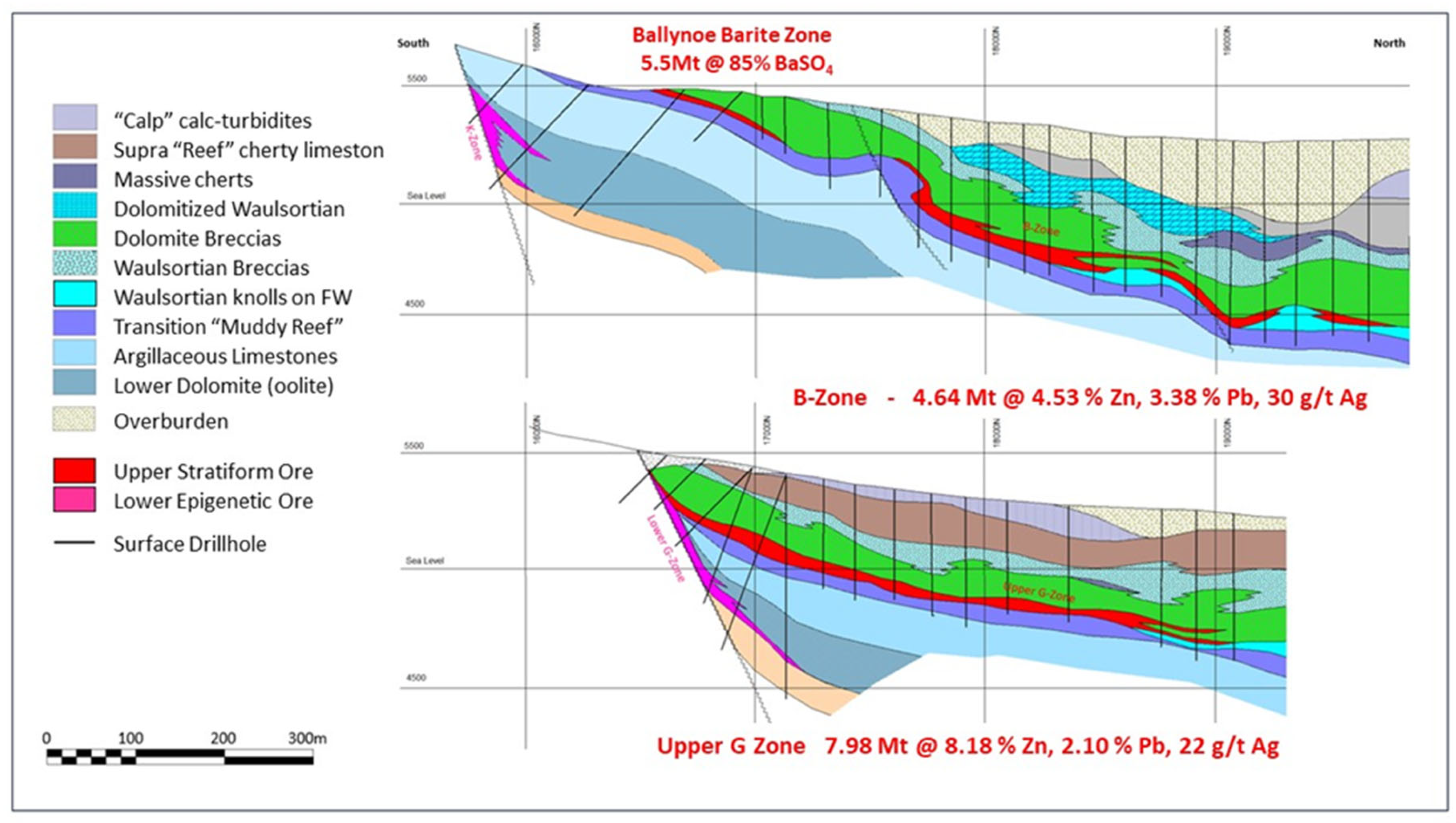
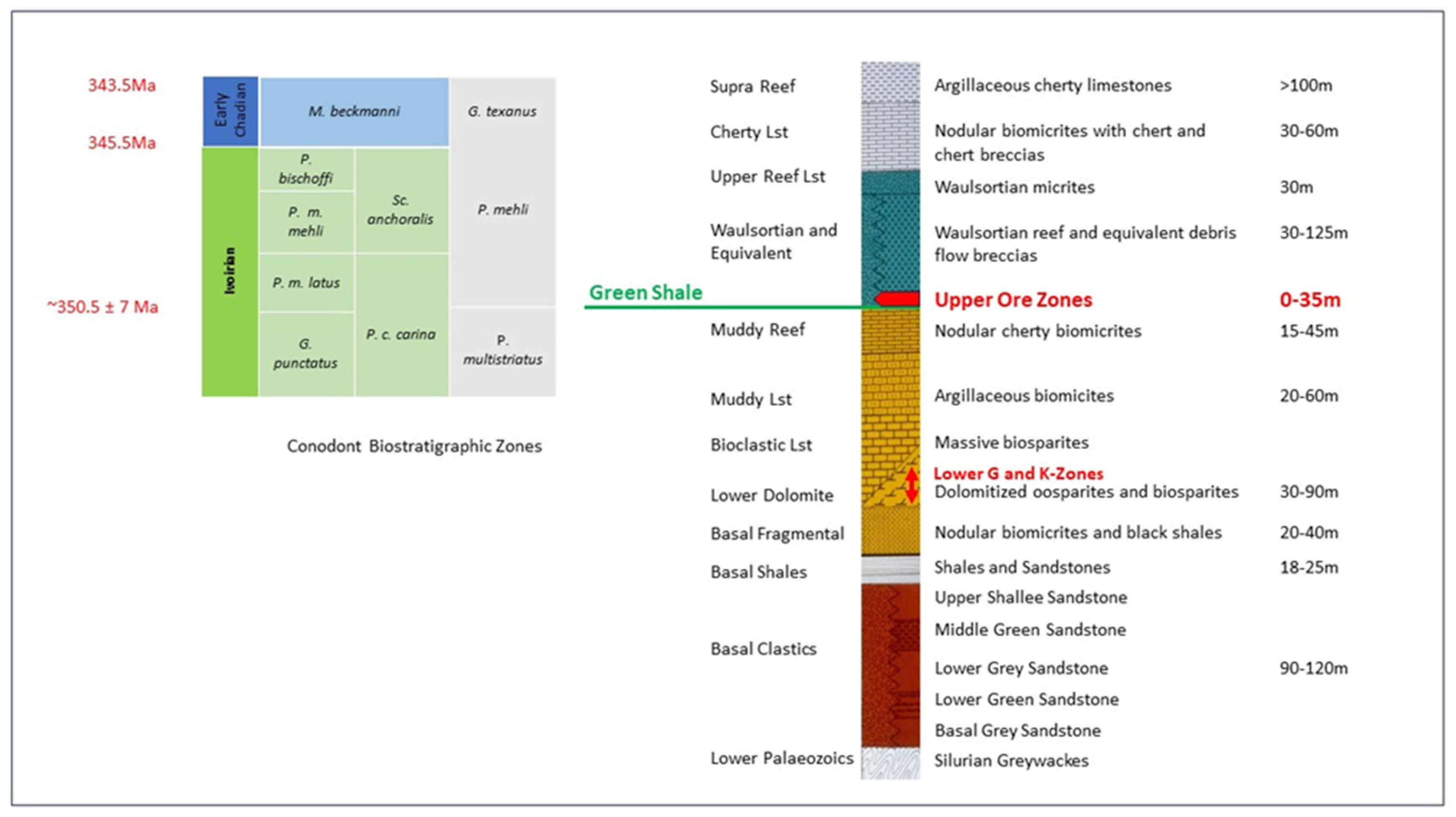
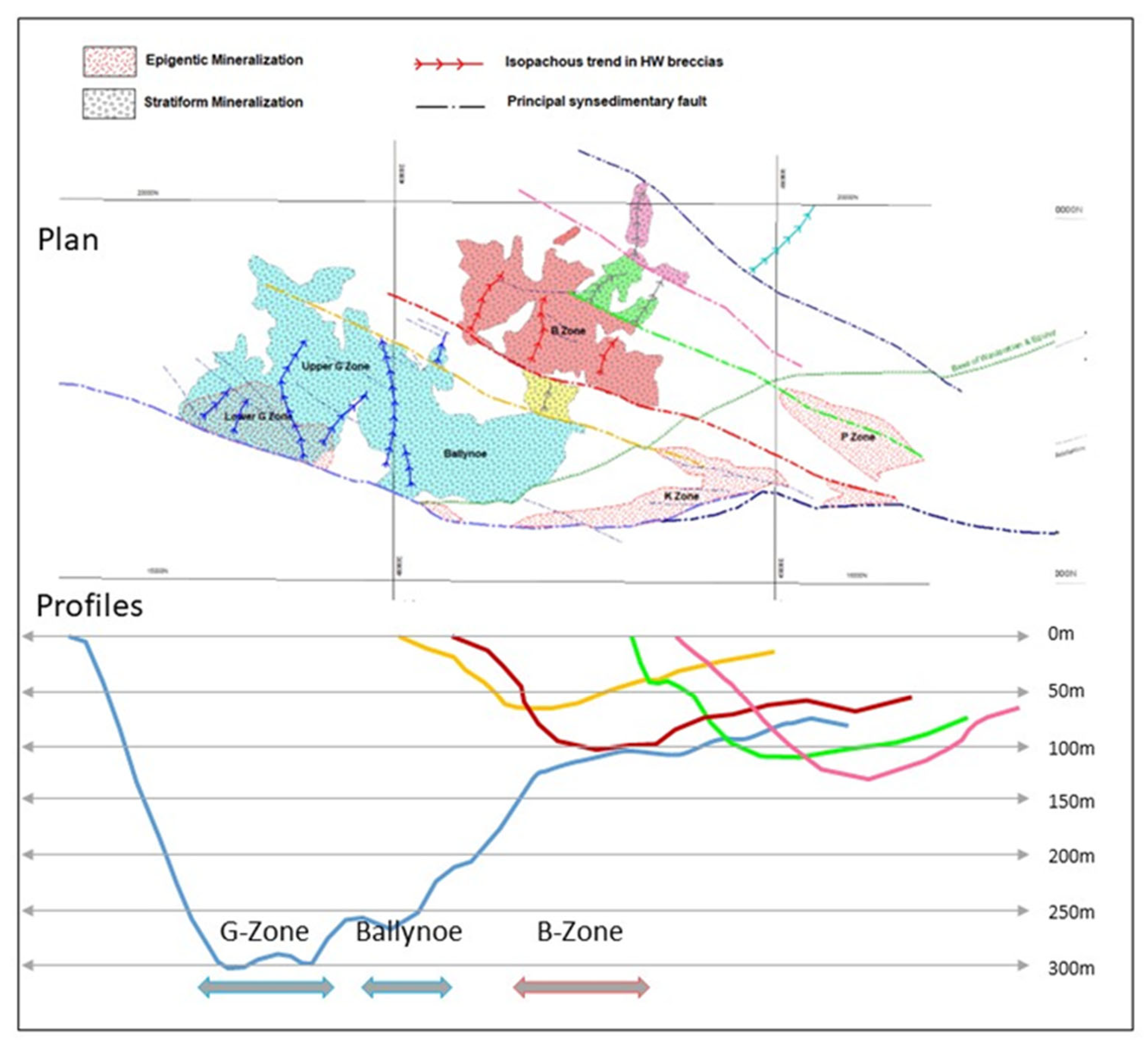
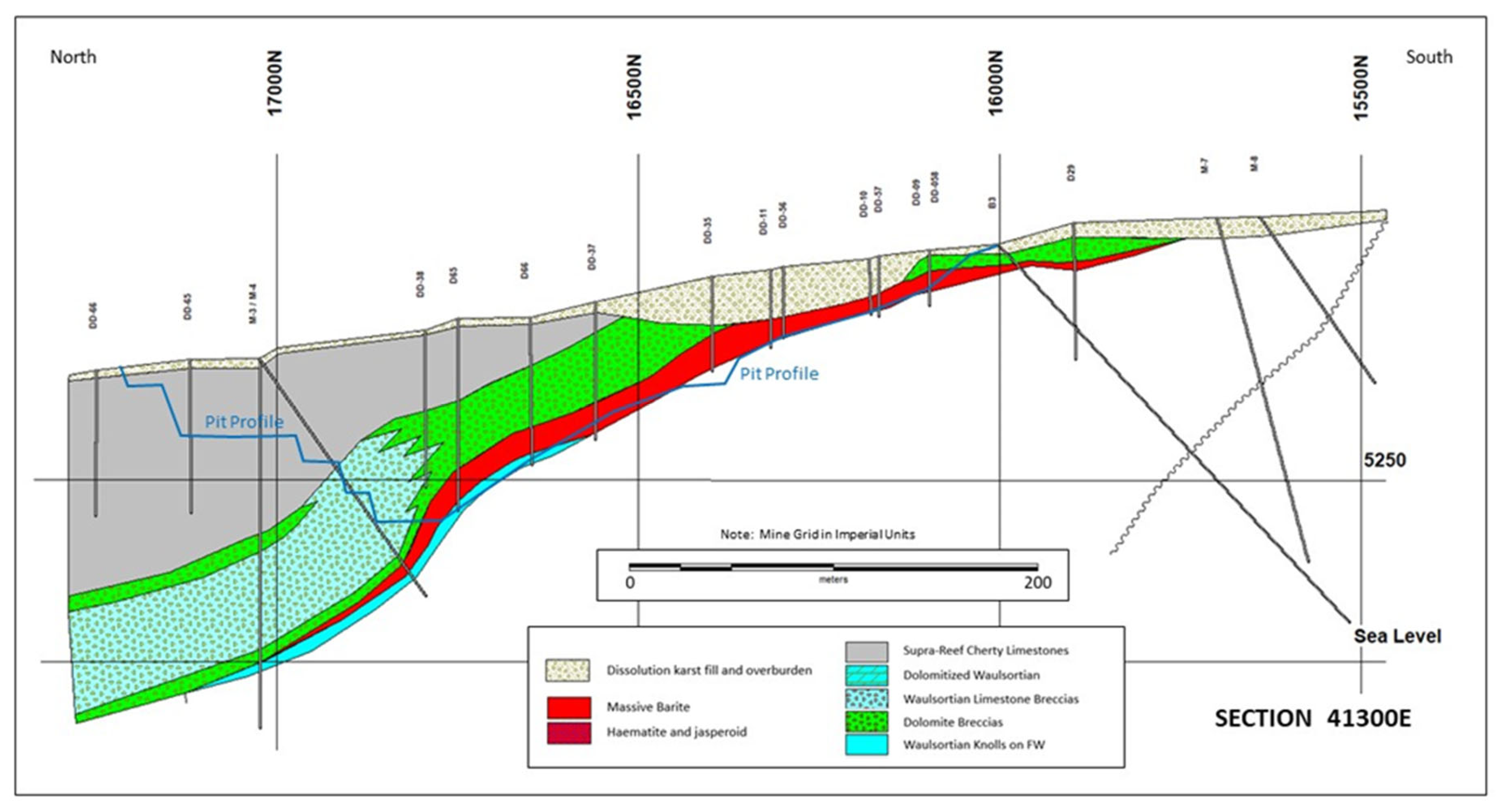
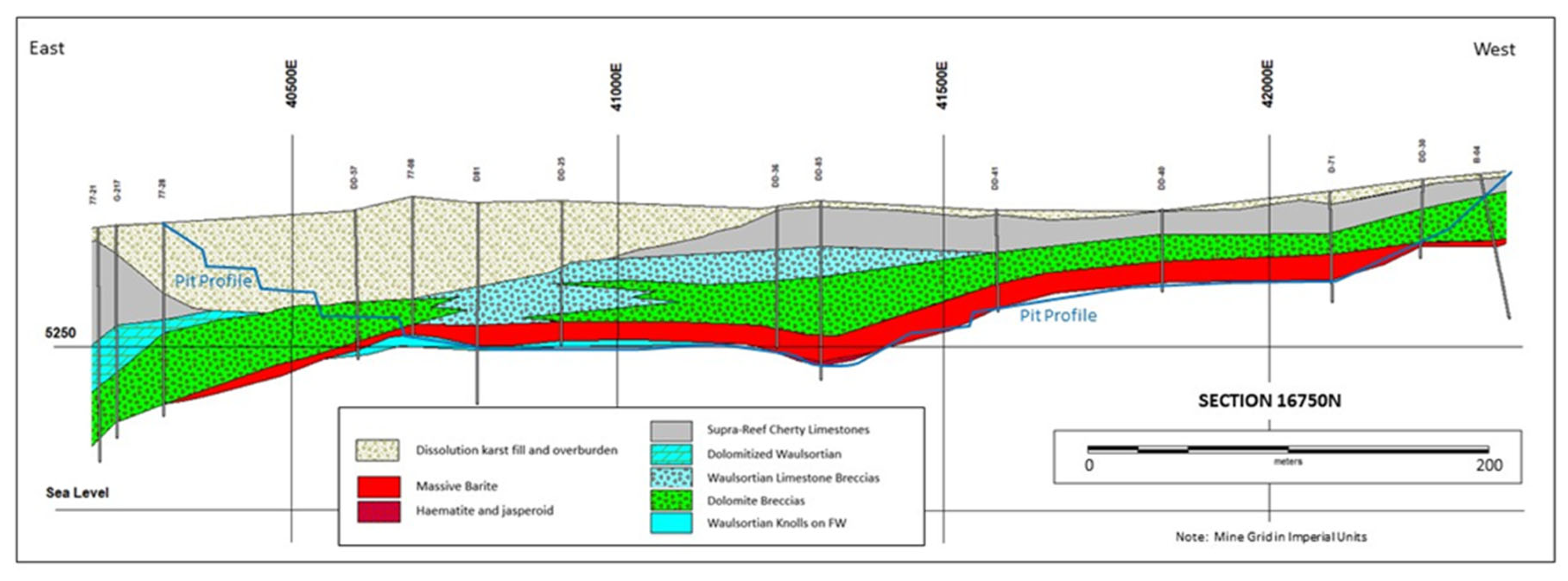
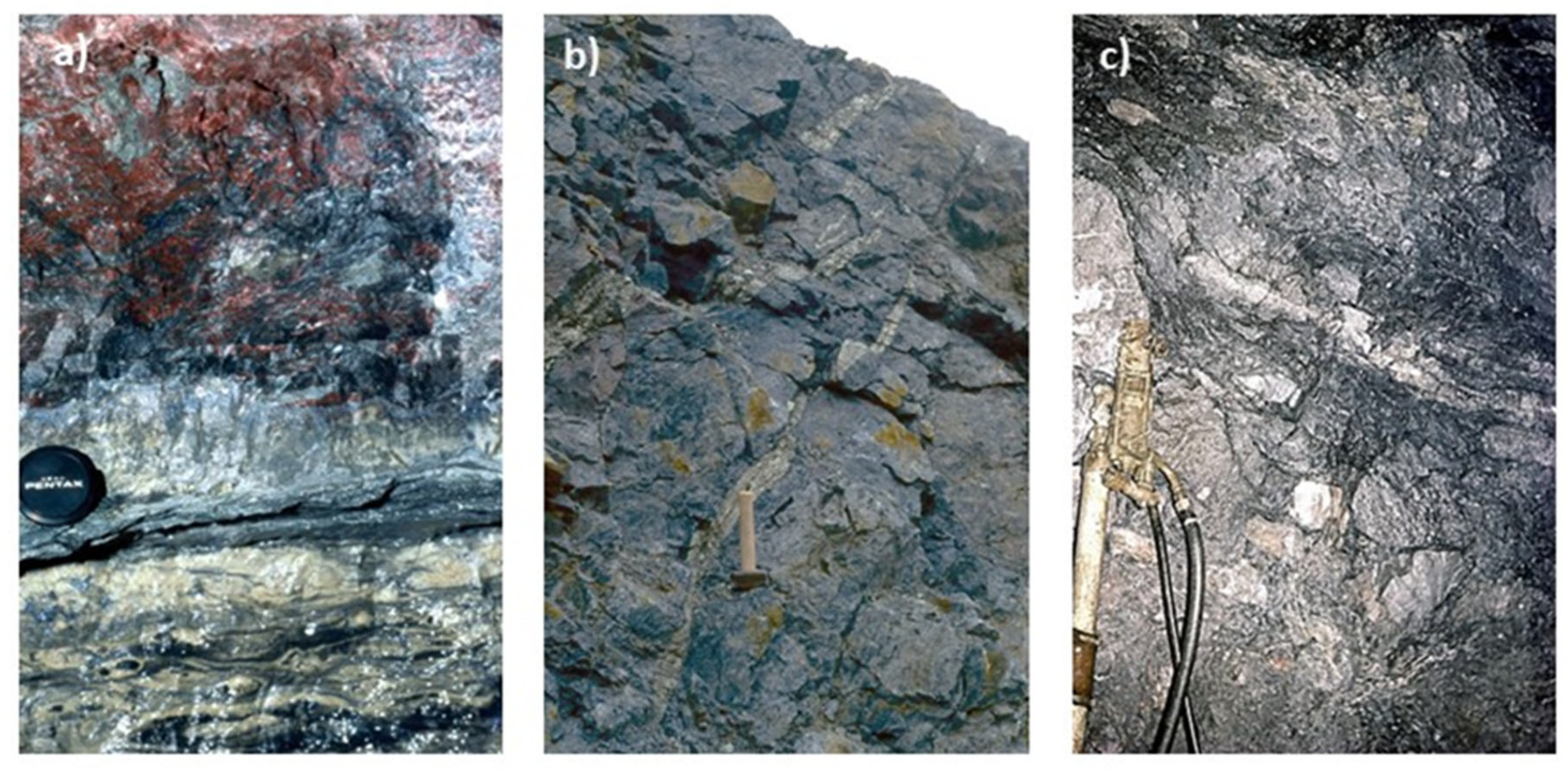
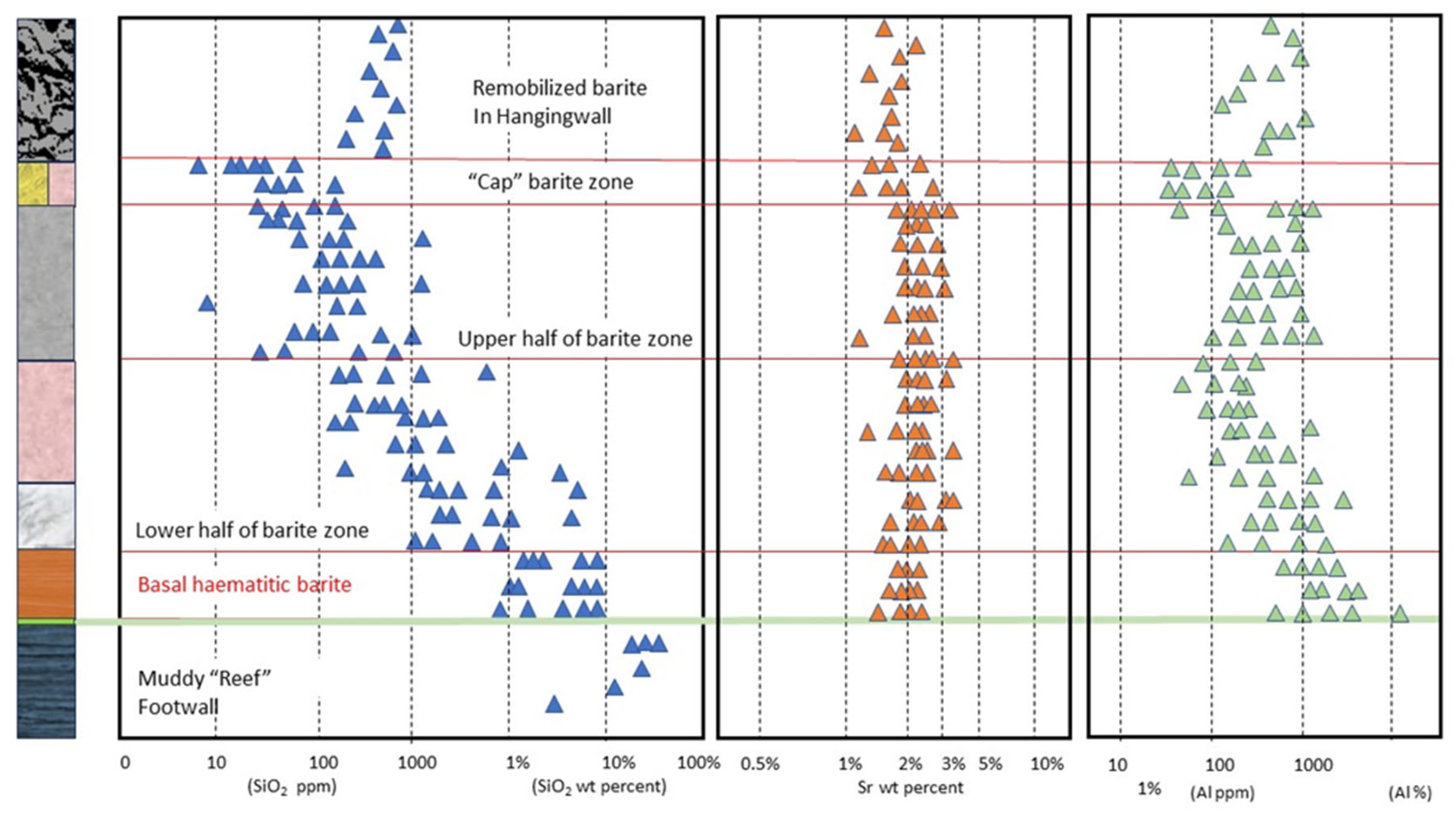
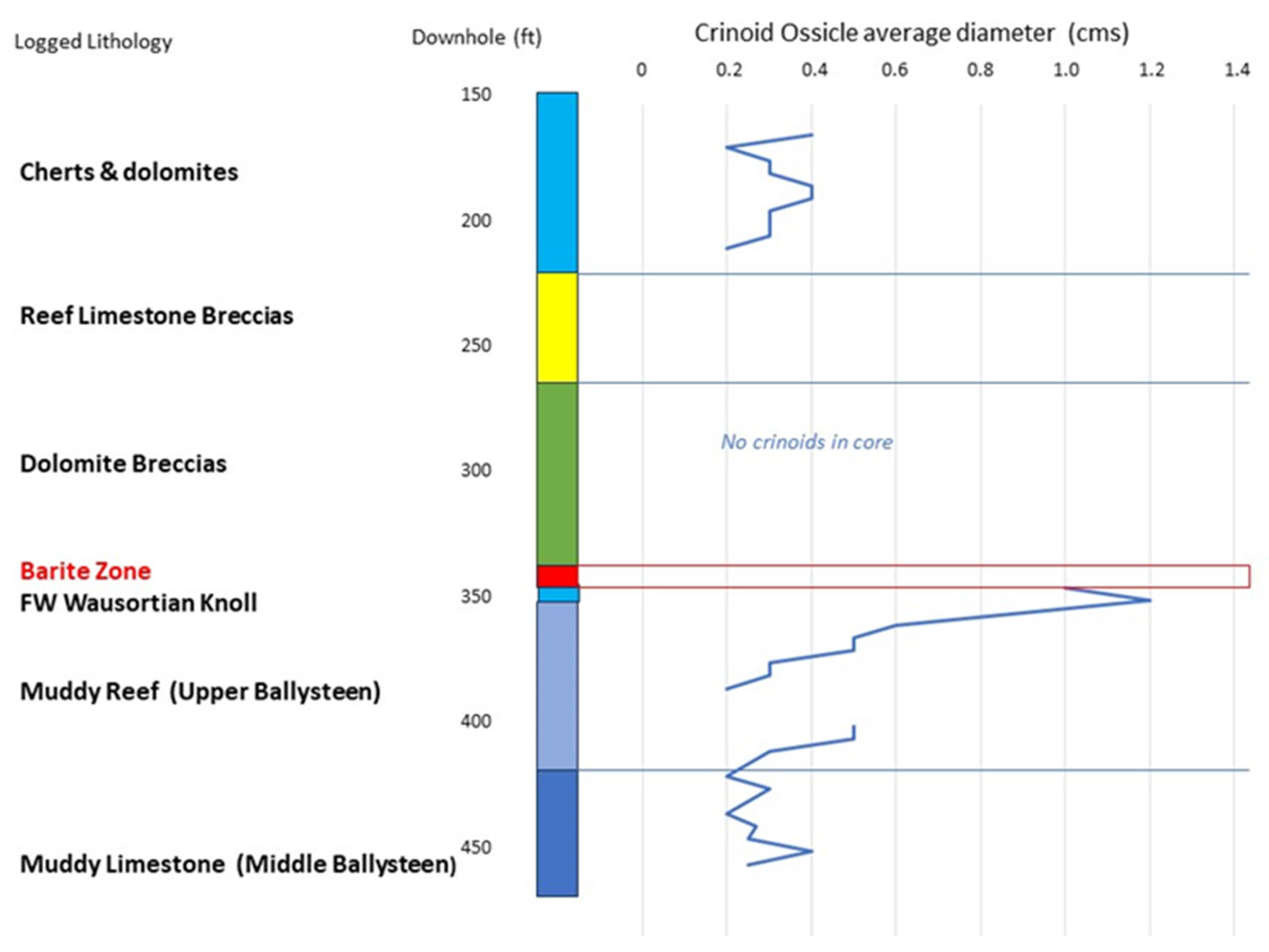
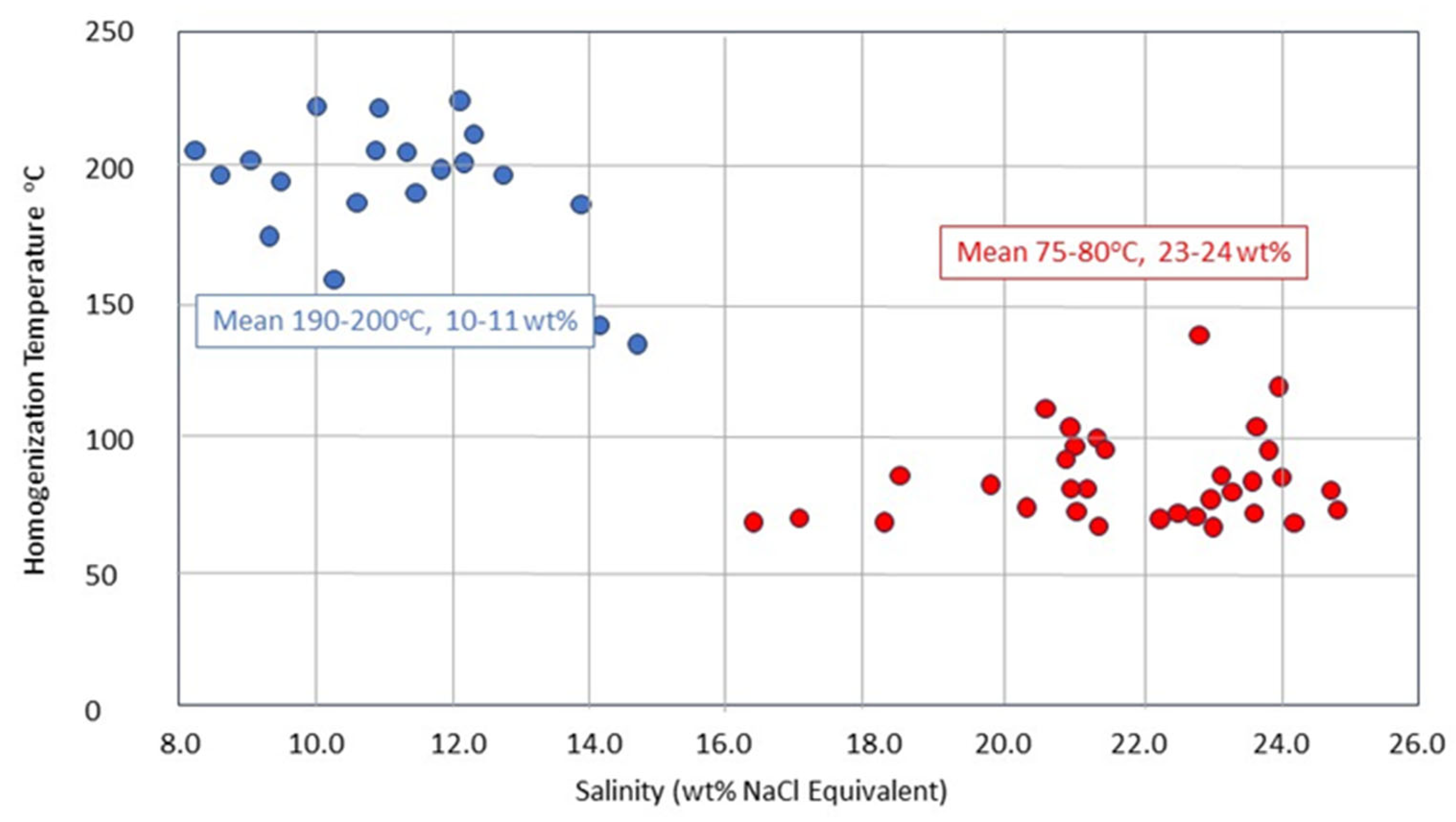
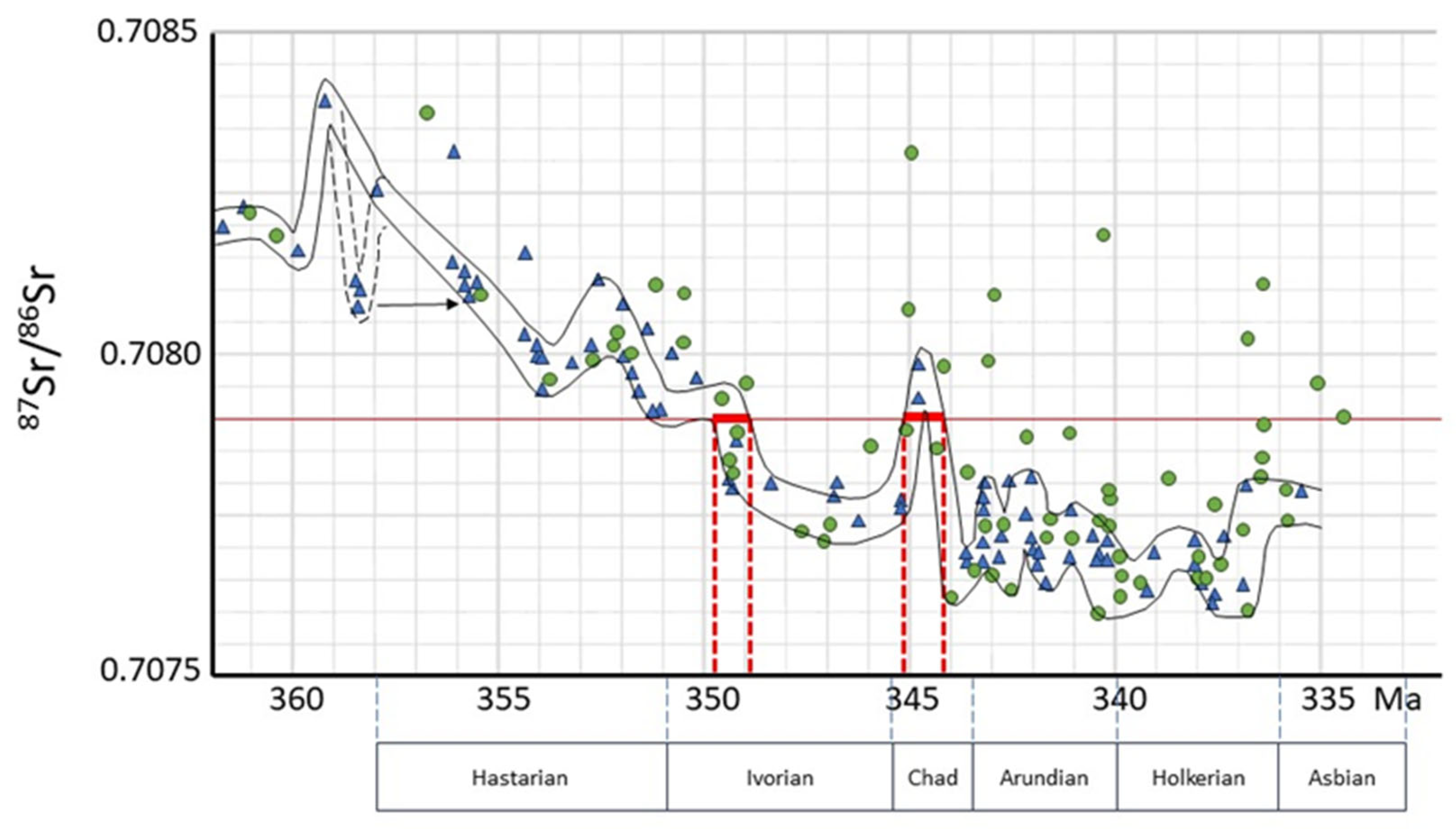
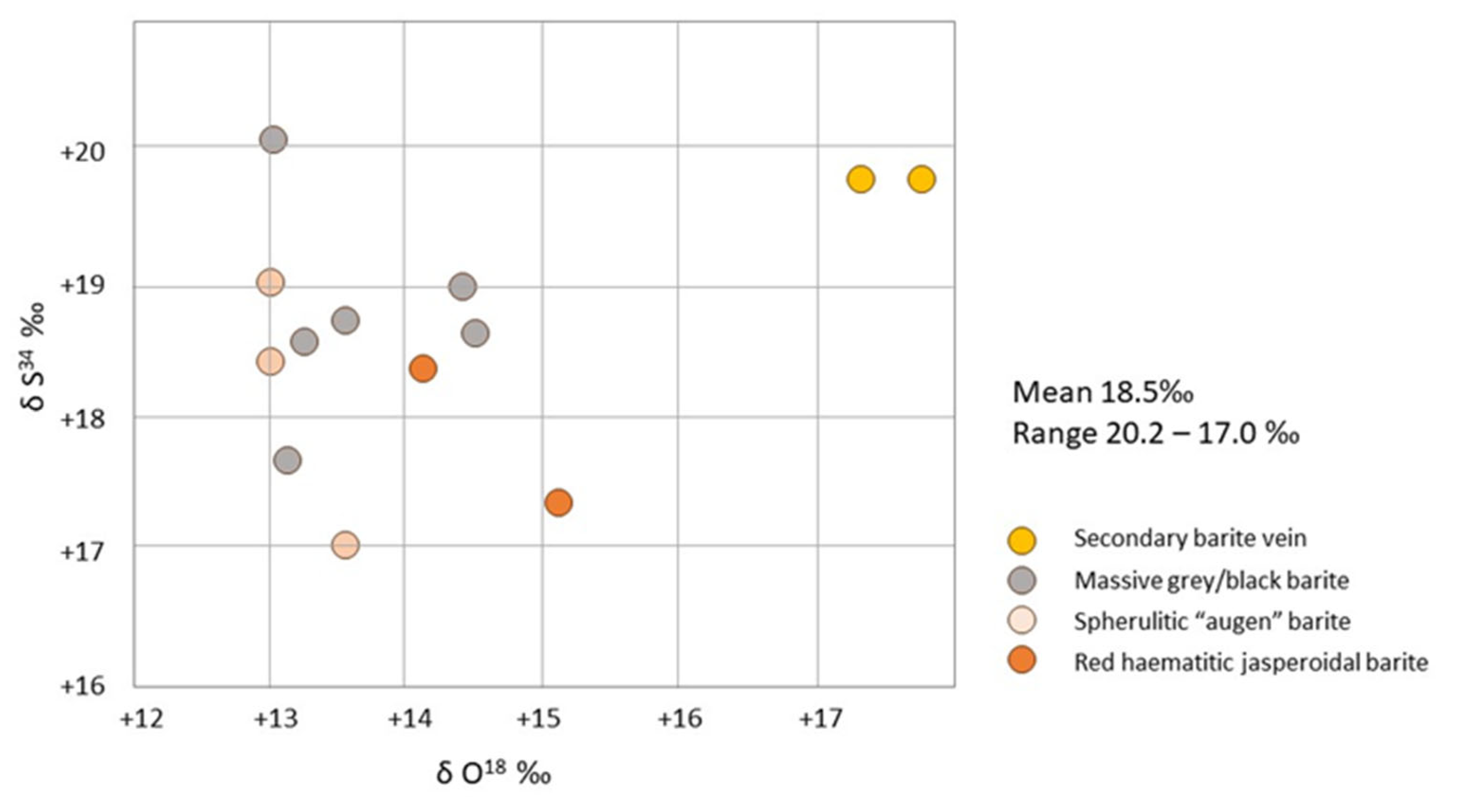
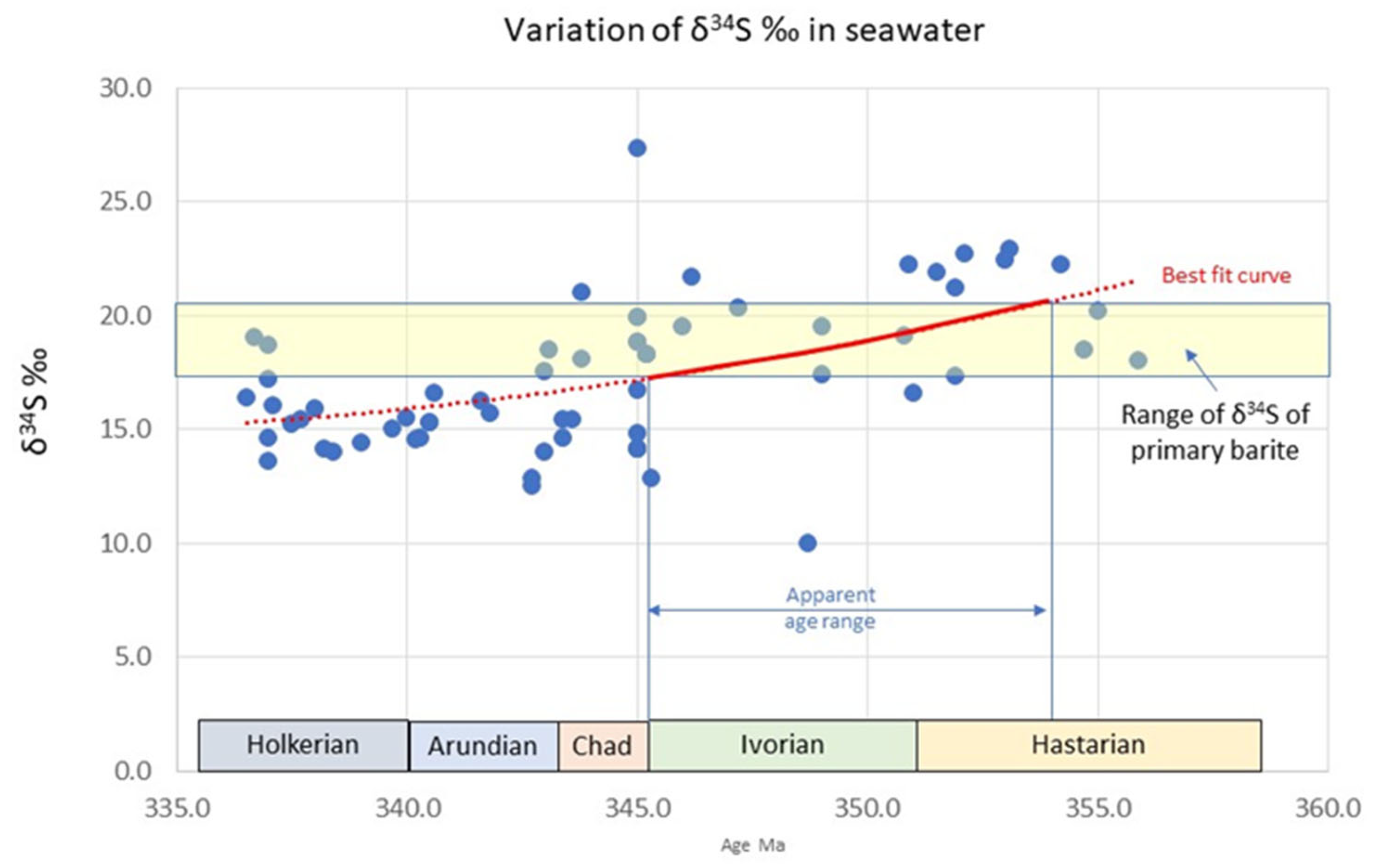
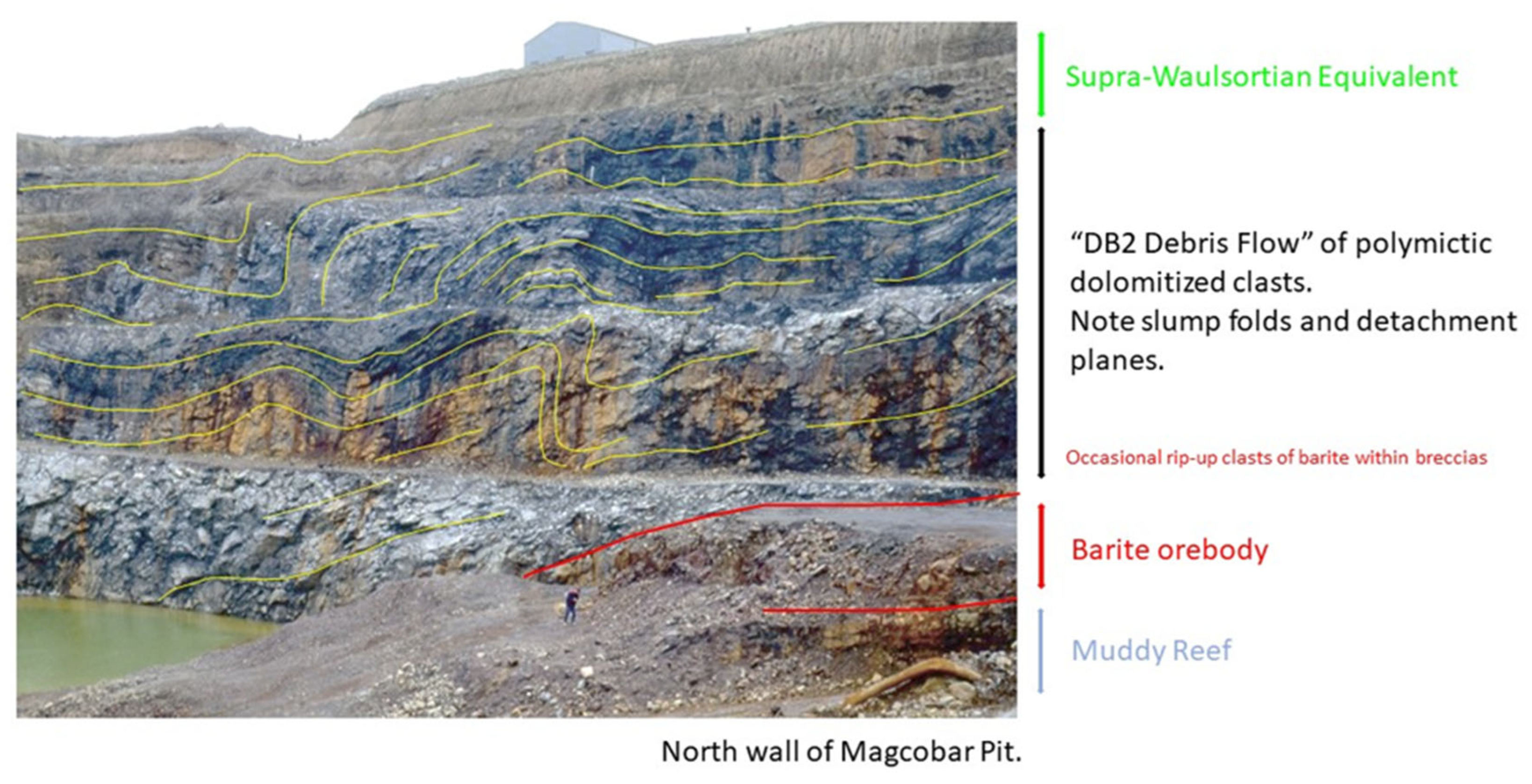

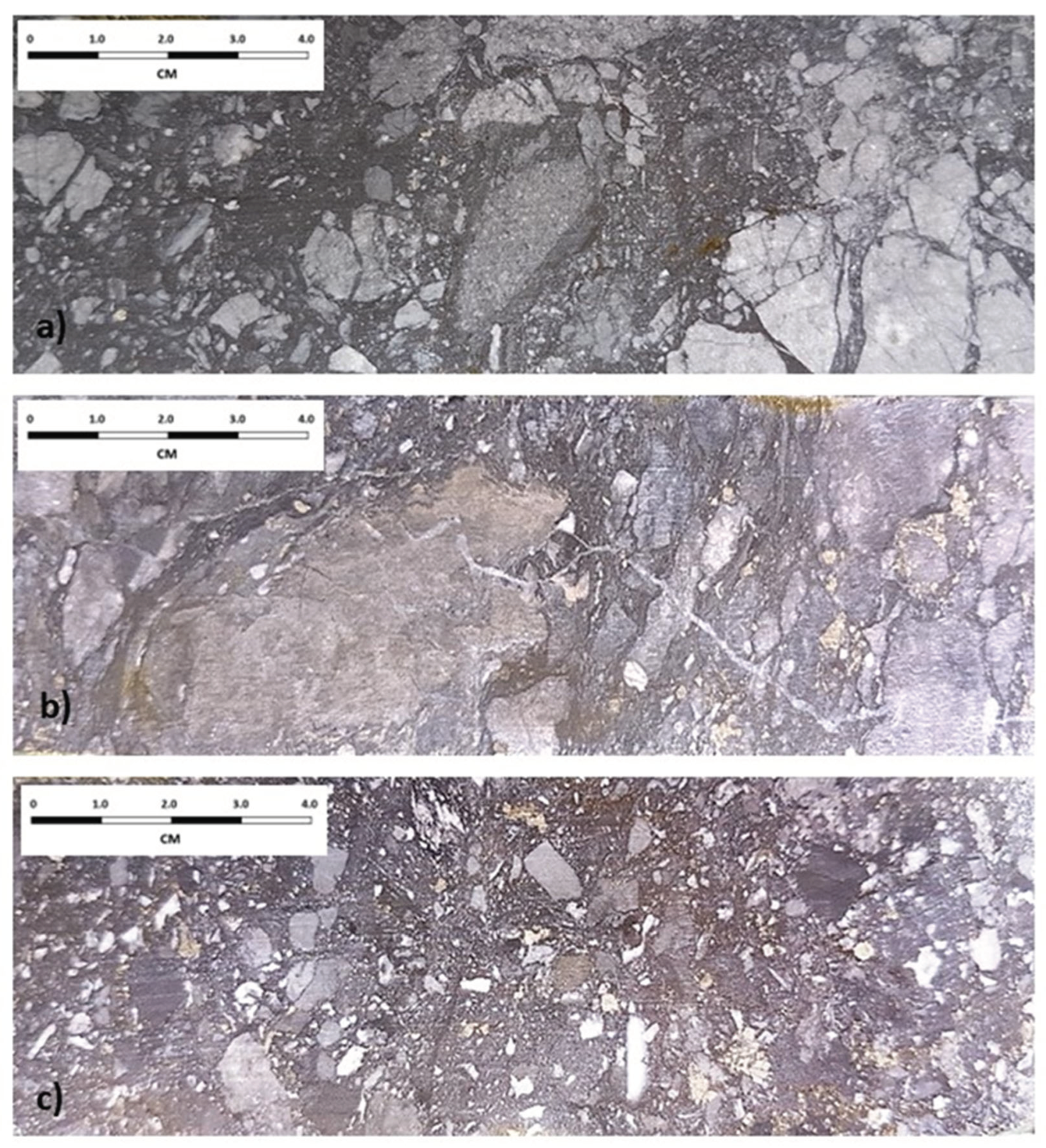
Disclaimer/Publisher’s Note: The statements, opinions and data contained in all publications are solely those of the individual author(s) and contributor(s) and not of MDPI and/or the editor(s). MDPI and/or the editor(s) disclaim responsibility for any injury to people or property resulting from any ideas, methods, instructions or products referred to in the content. |
© 2024 by the authors. Licensee MDPI, Basel, Switzerland. This article is an open access article distributed under the terms and conditions of the Creative Commons Attribution (CC BY) license (http://creativecommons.org/licenses/by/4.0/).



